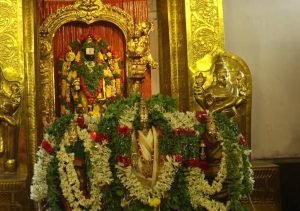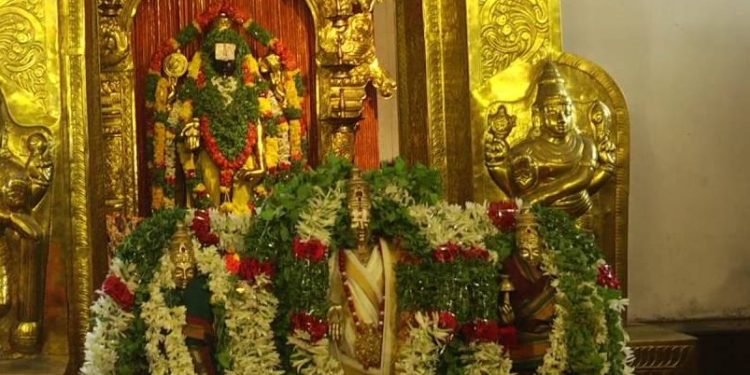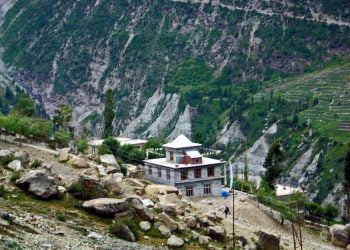Mythological Origins and Divine Legends
The Karigiri Venkateswara Temple is steeped in fascinating mythology that adds to its spiritual allure. According to local lore, there are three intriguing stories associated with the temple’s origins:
1. The Precious Stone: One of the most captivating legends speaks of a small, rare precious stone that belongs to the idol of Lord Venkateswara at Tirumala. This stone, believed to have been brought by celestial beings (Devathas), is said to be enshrined at the foot of the Lord’s idol in Karigiri, forming a tilaka shape. This connection to the famous Tirumala temple adds a layer of mystique to the Karigiri shrine.
2. Divine Sojourn: Another popular belief suggests that Lord Venkateswara and Goddess Padmavathi themselves visited and briefly resided at this location during their journey to Tirumala. This divine presence is thought to have sanctified the area, making it a place of great spiritual significance.
3. The Miraculous Footprint: Near an ancient pond beside the temple, devotees can witness a massive footprint impression on a rock, measuring nearly 3 feet in length. This is believed to be the footprint of Lord Vishnu, from which the holy river Ganga is said to have originated, forming a perennial pushkarini (sacred water body) at the site.
Historical Significance and Development
While the exact date of the temple’s construction remains unclear, it is estimated to be around 200 years old. The temple’s location atop Karigiri hill, at an elevation of approximately 2000 feet above sea level, suggests that it was built to provide a spiritual retreat for devotees seeking closeness to the divine.
Over the years, the temple has grown in prominence, attracting pilgrims from various parts of Andhra Pradesh and beyond. Its association with the more famous Tirumala Venkateswara Temple has contributed to its popularity, with many devotees considering it a sacred stop on their pilgrimage route.
Architectural Marvel
The Karigiri Venkateswara Temple, while not as grand as its Tirumala counterpart, possesses its own unique architectural charm. The temple is constructed in the traditional Dravidian style, common to many South Indian temples. Its design likely incorporates elements of the Agama Shilpa, a traditional architectural style that emphasizes harmony with cosmic energies.
Key architectural features of the temple include:
1. Gopuram: The temple likely features a modest gopuram (entrance tower) adorned with intricate carvings depicting various Hindu deities and mythological scenes.
2. Sanctum Sanctorum: The inner sanctum houses the main deity, Lord Venkateswara, along with his consort Goddess Padmavathi. The idols are believed to be over 200 years old, adding to their spiritual significance[4].
3. Mandapams: The temple complex may include various mandapams (pillared halls) used for different religious ceremonies and gatherings.
4. Sacred Pond: The ancient pond near the temple, associated with the legendary footprint of Lord Vishnu, forms an integral part of the temple complex and is considered holy by devotees.
Spiritual Significance and Rituals
The Karigiri Venkateswara Temple holds great spiritual importance for devotees. Some notable aspects of its religious significance include:
1. Brahmotsavam: The temple’s annual Brahmotsavam festival coincides with that of the Tirumala Balaji Temple, further cementing its connection to the more famous shrine.
2. Special Poojas: During the months of September and October, special poojas are conducted every Saturday for five consecutive weeks, attracting numerous devotees.
3. Sacred Cows: A unique feature of the temple is the presence of cows donated by devotees. These cows are said to graze freely during the day and return to the temple at night without any human guidance, a practice that has continued for years.

Conclusion
The Karigiri Sri Venkateswara Swamy Temple stands as a testament to the enduring faith and rich cultural heritage of Andhra Pradesh. Its mythological connections, historical significance, and spiritual ambiance continue to draw devotees seeking divine blessings and inner peace. As it stands majestically atop Karigiri hill, this ancient shrine serves as a bridge between earthly existence and celestial realms, inviting pilgrims to experience the divine presence of Lord Venkateswara in a serene and spiritually charged setting.
Shrine’s Map Location and How to Go There
By Road
The nearest bus stop is Uppal
By Rail
The nearest railway station is Secunderabad.
By Air
The nearest airport is Shamshabad Hyderabad.













































